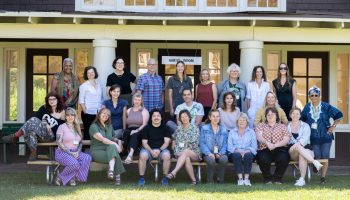
Julia Weber
Staff Writer
Adrienne Elise Tarver, an interdisciplinary visual artist working in painting, video, installation, sculpture and more, will deliver an artist lecture at 6:30 p.m. tonight in Hultquist Center as part of the Chautauqua Visual Arts Lecture Series.
Tarver is a guest faculty member in the Institution’s School of Art and has exhibited extensively both nationally and abroad. She received her Master of Fine Arts from the School of the Art Institute of Chicago. Her work is part of the 2025 School of Art faculty exhibition “Harmony,” curated by Susan and John Turben Director of CVA Galleries Judy Barie, which is on view now through Aug. 10 in Fowler-Kellogg Art Center.
As a faculty member in the residency program, Tarver brings the perspective garnered from her personal artistic practice to the program to teach residents about ways in which they might consider their individuality, personal experiences, relationship to place, and narratives through their own artistic practices. Tarver’s art practice is an intrapersonal inquiry in which she poses a series of questions about her relationship to self and space.
“I separate it into four core tenets of things that are ideas, concepts in my work,” Tarver said. “I separate it into place, person, presence and perception.”
“I am a very materials-interested artist, but also very conceptually- and research-driven,” she said. “There’s a lot of reading, and it’s so much about these ideas I’m interested in and thinking about the materials I’m interested in, how the meaning is elicited from material itself and how these things marry. There’s a lot of experimentation in my work and in the process.”
Tarver said her lecture will focus on her artistic evolution and her current body of work, which focuses on what she calls “aspirational spaces,” which are spaces that explore “our desires for where we want to go and how that manifests, the places we want to be (and) the places we want to build.”
For Tarver, a compelling reason for finding these aspirational spaces is because they provide an outlet for hope and community betterment amid difficult times.
“I find, because the world is pretty difficult right now and there’s so many disheartening things, that I’ve been enjoying looking at histories of how people have dealt with difficult times through thinking about things beyond our physical world,” she said.
She said she often finds herself asking questions such as “Where could I have belonged here 100 years ago, where could I belong today, where could I belong in the future?” when investigating her relationship to places through her work.
Because Tarver’s work is so invested in relationship to and sense of place, she said she is interested in further experiencing Chautauqua’s community as a place people become so attached to.
“I’m never really in a space without thinking about who or what happened there,” Tarver said. “I’m understanding the pride of Chautauqua and that people really are connected to this place. I’m very interested in where that has come from and what that is.”




